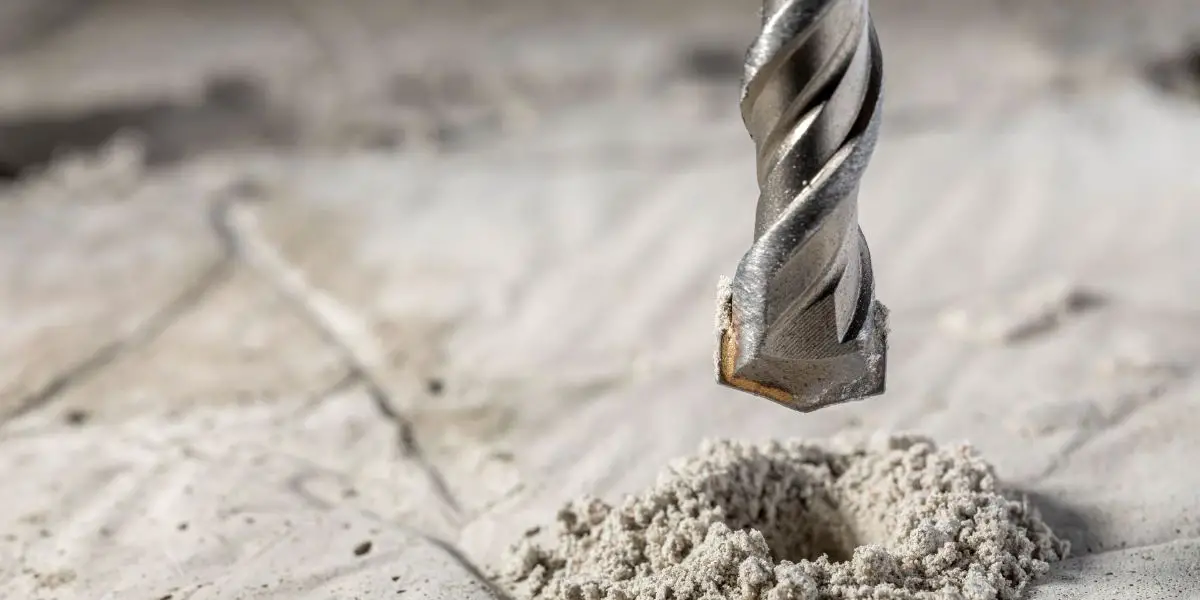Concrete is an integral part of most construction projects. The ability to accurately and efficiently drill into it is a vital skill for both professionals and DIY enthusiasts. This article aims to guide you through the steps you’ll need to take to achieve this. However, it’s important to note that it’s often cheap when using a company for diamond drilling in the UK due to the initial capital costs for the equipment.
Understanding the Basics of Concrete
Before we begin detailing the process of drilling into concrete, it’s crucial to have a fundamental understanding of what concrete is. This will also help you when it relates to different types of concrete.
Concrete is a composite material composed essentially of water, aggregate, and cement. The aggregate can be made up of various materials such as crushed stone, sand, gravel, or even recycled materials like crushed concrete. The cement acts as the binding agent, holding the aggregate together and providing strength to the final product.
Generally, concrete is a construction material that has high compressive strength. It’s durable and long-lasting, making it suitable for various infrastructure projects such as buildings, bridges, roads, and the like. The versatility of concrete allows it to be moulded into different shapes and sizes, making it a popular choice among architects and engineers.
Its inherent strength and durability in most environmental conditions make concrete an often preferred material. However, these properties also make concrete more challenging to work with, especially when it comes to drilling. Concrete is known for its hardness, which can make drilling into it a time-consuming and labour-intensive process.
What is Concrete?
Concrete is not just a simple mixture of water, aggregate, and cement. It undergoes a chemical reaction called hydration, where the cement particles react with water to form a paste that binds the aggregate together. This paste hardens over time, resulting in the solid and strong material we know as concrete.
The quality of the concrete depends on the ratio of water to cement used in the mixture. Too much water can weaken the final product, while too little water can make the concrete difficult to work with. Achieving the right balance is crucial for producing high-quality concrete.
Concrete also has excellent thermal properties, which means it can absorb and store heat energy. This makes it an ideal material for structures that require insulation, such as homes and commercial buildings. Additionally, concrete has good fire resistance, making it a safe choice for fire-resistant structures.
Different Types of Concrete
Not all concrete is created equally. There are various types, each having unique qualities that can affect how you go about drilling into it. Some common types include reinforced concrete, high-strength concrete, stamped concrete, and others.
Reinforced concrete is a type of concrete that contains a grid of steel bars or mesh embedded within it. This reinforcement provides additional strength and helps prevent cracking and structural failure. When drilling into reinforced concrete, it’s important to use specialised drill bits that can handle the presence of steel reinforcement.
High-strength concrete, as the name suggests, is a type of concrete that has a higher compressive strength compared to regular concrete. This makes it suitable for projects that require exceptional strength, such as high-rise buildings or heavy-duty infrastructure. Drilling into high-strength concrete may require more powerful drilling equipment and specialised techniques.
Stamped concrete is a decorative type of concrete that mimics the appearance of other materials like brick, stone, or tile. It is commonly used for patios, driveways, and walkways, where aesthetics play a significant role. When drilling into stamped concrete, extra care must be taken to avoid damaging the decorative surface.
Knowing the specific type of concrete you’ll be drilling will guide you in choosing the correct tools and techniques. For example, reinforced concrete contains a grid of steel bars that could potentially damage regular drill bits. By using diamond-tipped drill bits designed for reinforced concrete, you can ensure a smooth and efficient drilling process.

Essential Tools for Drilling into Concrete
Ensure you have the right tools at hand before embarking on your drilling project. Making sure you can safely and effectively cut through concrete includes having both the right drill and an appropriate drill bit.
Drilling into concrete requires precision and the use of specialised tools. It is crucial to select the correct equipment to ensure the success of your project. In addition to the basic tools, there are several factors to consider when choosing the right drill and drill bit for your specific needs.
Choosing the Right Drill
The type of drill you choose depends on the extent of your drilling project. For shallow, small-diameter holes, a regular hammer drill might suffice. This type of drill is versatile and commonly used for light masonry work. It combines the rotational motion of a regular drill with a forward, hammering action that helps penetrate the concrete surface.
On the other hand, for larger holes or deeper drilling, a rotary hammer is a better option. Rotary hammers are specifically designed for heavy-duty masonry work. They deliver a more powerful hammering action, making them ideal for drilling into thick concrete walls or floors. These tools often have additional features such as adjustable speed settings and depth stops, providing greater control and precision.
Whichever model you choose, make sure it’s rated for masonry work. Drills made specifically for concrete compression are equipped with a hammering action that chips away at the concrete whilst drilling. This feature ensures efficient drilling and reduces the risk of the drill getting stuck or overheating.
Understanding Drill Bits for Concrete
When it comes to masonry drilling, choosing the right drill bit is just as important as selecting the right drill. Masonry bits are usually made from harder materials such as carbide, which can withstand the abrasive nature of concrete.
The length and diameter of your drill bit will depend on the depth and width of the hole you need to drill. It’s important to remember that using a bit that’s too wide or too long can lead to unnecessary damage to the concrete. Carefully measure the dimensions of the hole you require and select a drill bit that matches those specifications.
Additionally, consider the type of drill bit tip that will best suit your needs. There are various options available, including pointed tips for precise drilling and flat tips for creating larger holes. Some drill bits also feature flutes or grooves along the shaft, which help remove debris from the hole and prevent overheating.
Safety Equipment You’ll Need
Safety is paramount when working with concrete and power tools. Basic safety equipment includes safety glasses or goggles, a dust mask, and durable gloves. These items protect your eyes, respiratory system, and hands from potential hazards such as flying debris and dust particles.
If you’re going to be drilling for an extended period or working in a noisy environment, ear protection may also be necessary. Constant exposure to loud drilling noises can cause hearing damage, so it’s essential to safeguard your ears with earplugs or earmuffs.
When drilling overhead or at chest level, consider wearing a hard hat or other suitable head protection. This precaution helps protect your head from falling debris or accidental bumps against hard surfaces.
Remember, safety should always be a priority when working with power tools and concrete. Take the time to familiarise yourself with the proper usage of the tools and equipment, and follow all safety guidelines provided by the manufacturer.
Preparing to Drill into Concrete
Once you’re equipped with the necessary tools and safety equipment, the next step is to prepare for drilling. This involves marking your drill points and setting up your drill correctly.
Marking Your Drill Points
Before starting to drill, determine exact drill points on the concrete. Use a pencil or chalk to mark the spots where you’ll be drilling. Always double-check your measurements to prevent any mistakes.
Remember, once you drill into concrete, there’s no going back. So accuracy at this stage is vital.
Setting Up Your Drill
Begin by installing the correct drill bit into your drill. Ensure it’s secure and well tightened. Then put on your safety gear.
Set up your drill by adjusting the clutch to the setting that’s suited for your type and size of concrete. This clutch will ensure that you don’t over torque and snap your drill bit. If your drill has a depth setter or a depth stop, use it to set the depth of your hole.
Step-by-Step Guide to Drilling into Concrete
With proper preparation and the right tools, it’s time to start drilling. Here is a step-by-step guide.
Starting the Drill Hole
Start with a slow speed to create an initial groove in the concrete, which will help to guide the bit. If your drill has a hammer function, turn it on now.
Hold the drill perpendicular to the concrete and apply steady pressure as you drill, but avoid pushing too hard as this can cause the bit to jam or break.
Drilling the Hole
Once you’ve created a starter hole, ramp up the drill speed and continue drilling. Every few seconds, withdraw the bit slightly to remove dust and prevent overheating.
Remember to maintain a consistent pressure on the drill, let the bit do the work rather than forcing it through the material.
Finishing Up the Drill Hole
When you approach the desired depth, lessen the pressure and slow down the drilling speed. Once you’ve reached the correct depth, stop drilling and remove the drill bit from the hole.
After you’ve drilled your hole, clean it out by blowing away the dust. This can be done using compressed air or a shop vacuum.
Tips and Tricks for Drilling into Concrete
Now that you’ve mastered the basics, here are some advanced tips and tricks to help you get the most out of your drilling.
How to Avoid Cracking the Concrete
The key to preventing cracks when drilling into concrete is to use the right tools and techniques. Always use masonry bits and drills designed for concrete. Look for drills with a hammering action, as this will chip away at the concrete instead of drilling, reducing the risk of cracks.
Another great tip is to avoid drilling too fast. This can cause the concrete to crack from the heat generated. Always start slow, let the drill bit do the work, and take breaks to let your drill bit cool down.
What to Do If Your Drill Bit Gets Stuck
If your drill bit gets stuck in the concrete, the first thing to do is to turn off the drill and unplug it. Try to gently wiggle the bit to see if it will come free. If this doesn’t work, you may need to use pliers or vice grip to get more leverage.
In some cases, you might need to carefully chip away some of the concrete around the bit using a hammer and chisel. In more severe cases, it might be necessary to drill a release hole next to the stuck bit. However, always remember that safety comes first, and calling in a professional may be the best course of action if you’re unsure.
The process of drilling concrete can be challenging, but with the right preparation, the correct tools, and a bit of practice, you’ll quickly get the hang of it. Always be sure to maintain safety precautions at all times. Happy drilling!


